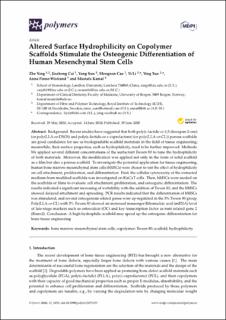| dc.contributor.author | Xing, Zhe | |
| dc.contributor.author | Cai, Jiazheng | |
| dc.contributor.author | Sun, Yang | |
| dc.contributor.author | Cao, Mengnan | |
| dc.contributor.author | Li, Yi | |
| dc.contributor.author | Xue, Ying | |
| dc.contributor.author | Finne-Wistrand, Anna | |
| dc.contributor.author | Mustafa, Kamal Babikeir Eln | |
| dc.date.accessioned | 2021-08-06T10:05:31Z | |
| dc.date.available | 2021-08-06T10:05:31Z | |
| dc.date.created | 2021-02-28T18:06:33Z | |
| dc.date.issued | 2020 | |
| dc.identifier.issn | 2073-4360 | |
| dc.identifier.uri | https://hdl.handle.net/11250/2766775 | |
| dc.description.abstract | Background: Recent studies have suggested that both poly(l-lactide-co-1,5-dioxepan-2-one) (or poly(LLA-co-DXO)) and poly(l-lactide-co-ε-caprolactone) (or poly(LLA-co-CL)) porous scaffolds are good candidates for use as biodegradable scaffold materials in the field of tissue engineering; meanwhile, their surface properties, such as hydrophilicity, need to be further improved. Methods: We applied several different concentrations of the surfactant Tween 80 to tune the hydrophilicity of both materials. Moreover, the modification was applied not only in the form of solid scaffold as a film but also a porous scaffold. To investigate the potential application for tissue engineering, human bone marrow mesenchymal stem cells (hMSCs) were chosen to test the effect of hydrophilicity on cell attachment, proliferation, and differentiation. First, the cellular cytotoxicity of the extracted medium from modified scaffolds was investigated on HaCaT cells. Then, hMSCs were seeded on the scaffolds or films to evaluate cell attachment, proliferation, and osteogenic differentiation. The results indicated a significant increasing of wettability with the addition of Tween 80, and the hMSCs showed delayed attachment and spreading. PCR results indicated that the differentiation of hMSCs was stimulated, and several osteogenesis related genes were up-regulated in the 3% Tween 80 group. Poly(LLA-co-CL) with 3% Tween 80 showed an increased messenger Ribonucleic acid (mRNA) level of late-stage markers such as osteocalcin (OC) and key transcription factor as runt related gene 2 (Runx2). Conclusion: A high hydrophilic scaffold may speed up the osteogenic differentiation for bone tissue engineering. | en_US |
| dc.language.iso | eng | en_US |
| dc.publisher | MDPI | en_US |
| dc.rights | Navngivelse 4.0 Internasjonal | * |
| dc.rights.uri | http://creativecommons.org/licenses/by/4.0/deed.no | * |
| dc.title | Altered surface hydrophilicity on copolymer scaffolds stimulate the osteogenic differentiation of human mesenchymal stem cells | en_US |
| dc.type | Journal article | en_US |
| dc.type | Peer reviewed | en_US |
| dc.description.version | publishedVersion | en_US |
| dc.rights.holder | Copyright 2020 The Authors | en_US |
| dc.source.articlenumber | 1453 | en_US |
| cristin.ispublished | true | |
| cristin.fulltext | original | |
| cristin.qualitycode | 1 | |
| dc.identifier.doi | 10.3390/polym12071453 | |
| dc.identifier.cristin | 1894314 | |
| dc.source.journal | Polymers | en_US |
| dc.identifier.citation | Polymers. 2020, 12 (7), 1453. | en_US |
| dc.source.volume | 12 | en_US |
| dc.source.issue | 7 | en_US |

